Afghanistan: « The Land of 1000 Golden Cities » and the Story of Ai-Khanoum
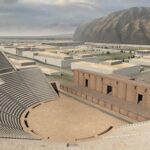
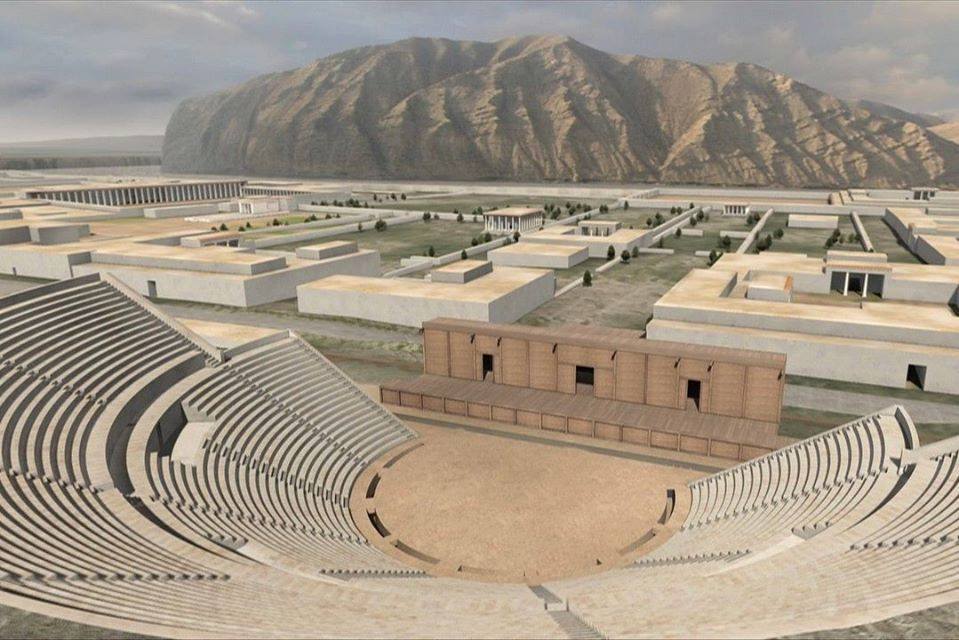

Edited transcript of Karel Vereycken’s presentation at the workshop on the « Cultural heritage of Afghanistan », presented in Kabul on Nov. 7 at the International conference on the economic reconstruction of Afghanistan organized by the Ibn-e-Sina Research and Development Center.
To talk about the culture of a foreign country is always a difficult thing to do, especially if one doesn’t know the language and if one wasn’t able to stay and travel around the country for a longer period. Therefore, I only can offer some impressions from the outside and things I read in books. So probably you will have to correct those things that escaped my attention.
Seen from the outside, Afghanistan is a fascinating country. Its reputation as the “Graveyard of Empires” captured my imagination. Most recently, Afghanistan resisted American and NATO occupation. A handful of determined combatants defeated a huge Empire already in the process of defeating itself. Before, Afghanistan resisted Russian occupation. And in the XIXth century, it resisted the British Empire during three Anglo-Afghan wars: the first in 1839-42, the second in 1878-1880 and the third one in 1919. Britain was playing the “Great Game”, trying to prevent Russia from getting access to the warm waters of the Arab gulf and the Indian Ocean. To prevent being colonized by both Russia and Britain, Afghanistan even courageously refused to have railroads, explaining why there only exists 300 km of rail today, a situation of course inacceptable today.
This capacity to resist, this quality of self respect and dignity, I think, derives from the fact that Afghanistan, being a roundabout on what was called the Silk-Road, absorbed and integrated into its own culture the best of the various influences that came to meet in this region and this became over centuries the foundation upon which was built the Afghan identity.
Totally opposed to that, foreign colonial powers, of course, always have wanted to erase the history, culture and heritage of the subjects over which they want to rule by “divide and conquer”. Justifying themselves as the unifying central power, they always pretend locals are mere representatives of eternally quarreling tribes.
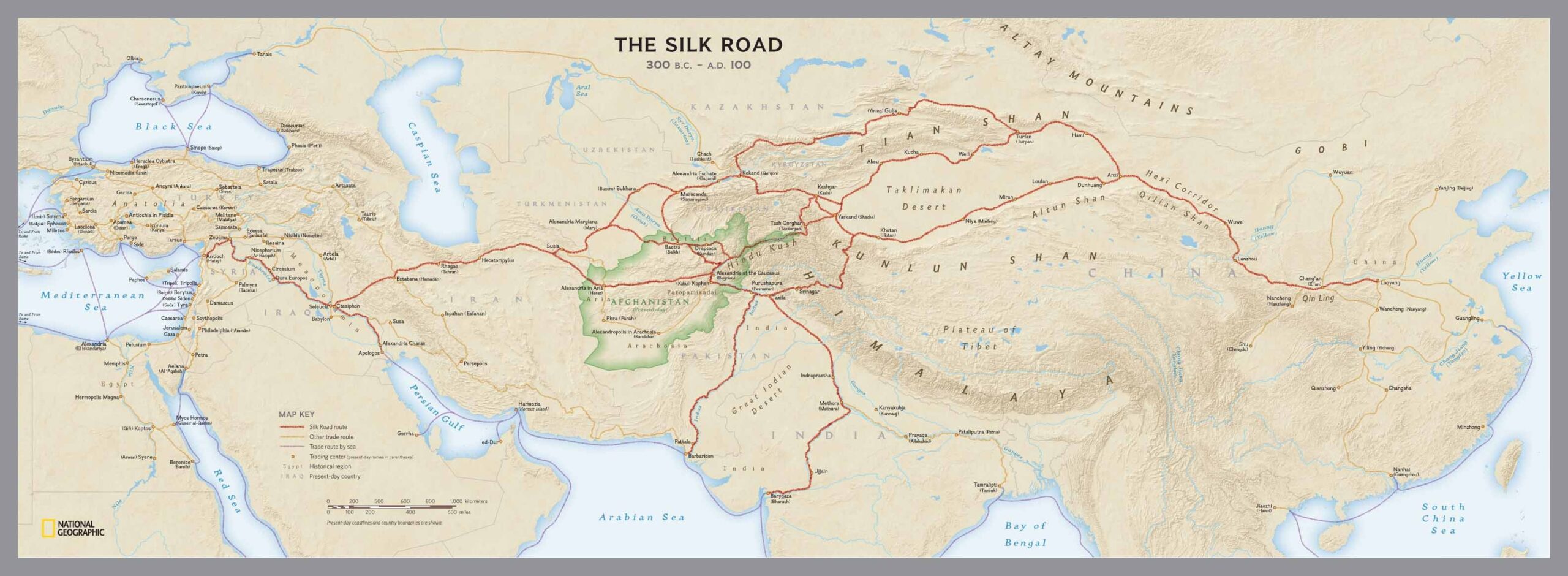
The Greek influence along this trade spread massively into Central Asia in the IVth Century BC with Alexander the Great (356 BC – 323 BC) crossing the Hindu Kush mountain range in 329 BC.
Alexander and his successors brought with them thousands of Greek settlers sometimes called the « The Ionians ». Greek influence, before reaching regions as distant from Macedonia as India, would last at least till the arrival of Islam in the VIIIth Century.
The Greco-Bactrian Kingdom
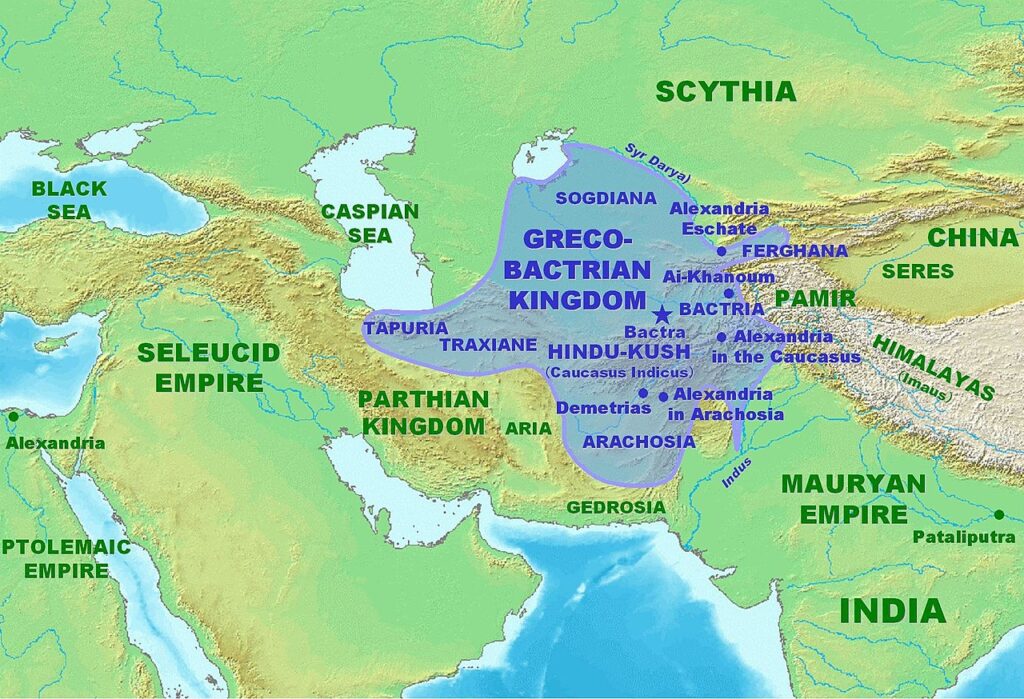
Under the rule of his competing successors, Alexander the Great’s huge empire collapsed into various entities and kingdoms.
One of them, and I will limit myself to this one as an example, stands what today’s historians call the Greco-Bactrian Kingdom or Bactria (or Bactriana), where Greek influence can be thoroughly documented by archeological findings that demonstrate an exceptional urban, economic, social and cultural development.

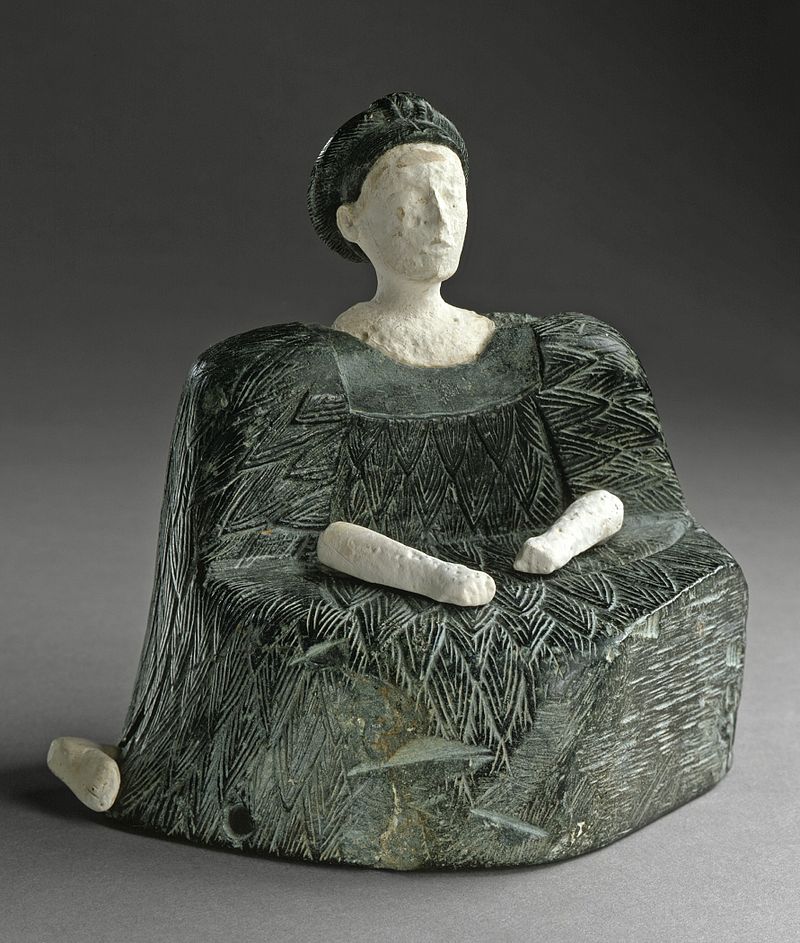
Bactria was founded in 256 BC by the Seleucid (persian) satrap Diodotus I Soter and lasted till its fall in 145 BC. Its territory stretched out from the Parthian Empire at its West side, to the North of the Indus River Valley civilization, much older, at its East. It covered much of present-day Afghanistan, Uzbekistan, Tajikistan, and Turkmenistan, and some parts of Iran and Pakistan.
Among the largest and richest cities of antiquity one counts cities as Ai-Khanoum and Bactria‘s capital Bactra (todays Balkh, some kilometers east of Mazar-e-Shariff in Afghanistan), the city where Ibn-Sina’s father, before moving to Buchara, currently Uzbekistan, was born.
Centuries before, it was also in Balkh, that Alexander the Great married Roxana (« Little Star »), the daughter of a Bactrian warlord and adopted local dress in a vast effort to create peace inside his Empire.
Strabo (64 or 63 BC – c. 24 AD), as many other Greek historians, referred to Bactria as « The Land of a 1000 Golden Cities », a land that all writers, both ancient and modern, praised for its gentle climate and fertility:
« Bactria produces everything, except olive oil. »
And for the Roman naturalist Pliny the Elder (AD 23/24 – AD 79), in Bactria,
« the grains of wheat grow so large that a single grain is as big as our ears of corn. »
Often erected at key strategic positions of trading routes, over time Bactria‘s cities became significant cultural centers where local and Greek traditions interacted and blended in artistic areas, as well as in architecture and religion.
Greeks lived alongside the local population in these places. The Greek language was used in this Central Asian region for administrative, economic, and philosophical matters. However, due to the constant flow of ideas and people of different professions, it was employed alongside local languages.
It is sufficient to look at the Greek names of many afghan cities to realize how predominant the Greek heritage is in this country.
Nearly all cities founded by Alexander the Great were of course called “Alexandria”, the best known being the major port of Egypt where Greek scientists such as Eratosthenes and others worked and lived.
- Ghazni, for example, was simply named “Alexandria” (in Opiana);
- Bagram, mainly known as the former US Airbase, was called “Alexandria in the Caucasus” and “Kapisa” in the Middle Ages.
- Kandahar had a Greek name: “Alexandria Arachosia”;
- Herat was “Alexandria Ariana”;
- Merv in today’s Turkmenistan was named “Alexandria” and later “Antiochia in Margiana”.
And the list doesn’t end there.
Also part of Bactria, the city and oasis of Gonur Depe (now in Turkmenistan, north of Mary, the ancient Merv), capital of the Kingdom of Margiane, is another example of what has been called the Bactro-Margian Archeological Complex (BMAC), more recently rebranded as the « Oxus Culture ».
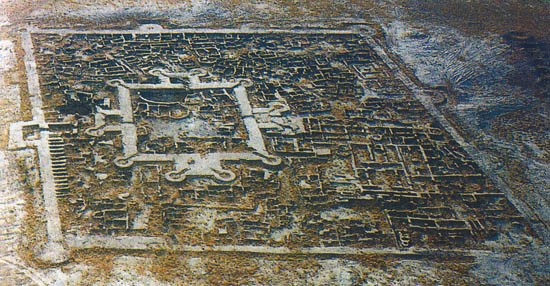
Other parts of today’s Afghanistan also came under the influence of Hellenistic culture under the rule of what are called the “Indo-Greek” Kingdoms, but that is yet another long story which I will not tell today.
Ai-Khanoum, the Greek
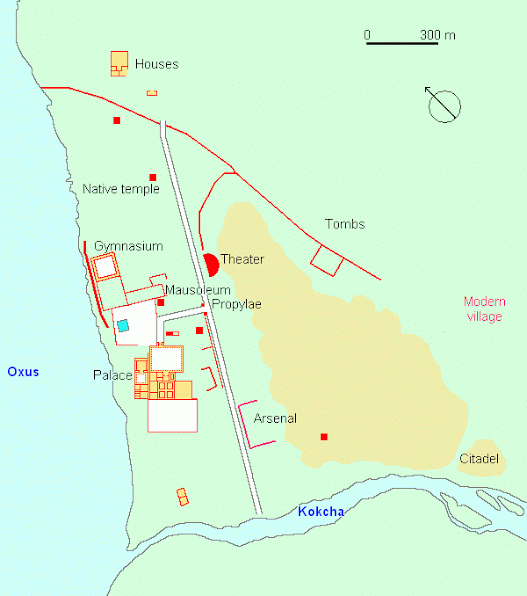
Some cities in Bactria just got new names, but others were entirely built new or given a new beginning. Such seems to have been the case of an ancient city whose name remains unknown but who became known over centuries as Ai-Khanoum (meaning “Lady Moon” in Uzbek).
The city was beautifully located at the confluence of the Amou Daria (the Greek “Oxus”) and the Kokcha rivers.
In 1961, after visiting the site on a hunting trip, the King of Afghanistan, (Mohammed Zahir Shah), showed huge interest.
Invited by Afghanistan, which wanted to mark its independance from both the Soviets and the US, it was a French archaeological delegation, led by Paul Bernard of the Département des archéologues français en Afghanistan (DAFA), that unearthed the remains of a huge palace in the lower town, along with a large gymnasium, a theater capable of holding 6000 spectators, an arsenal, and two sanctuaries.
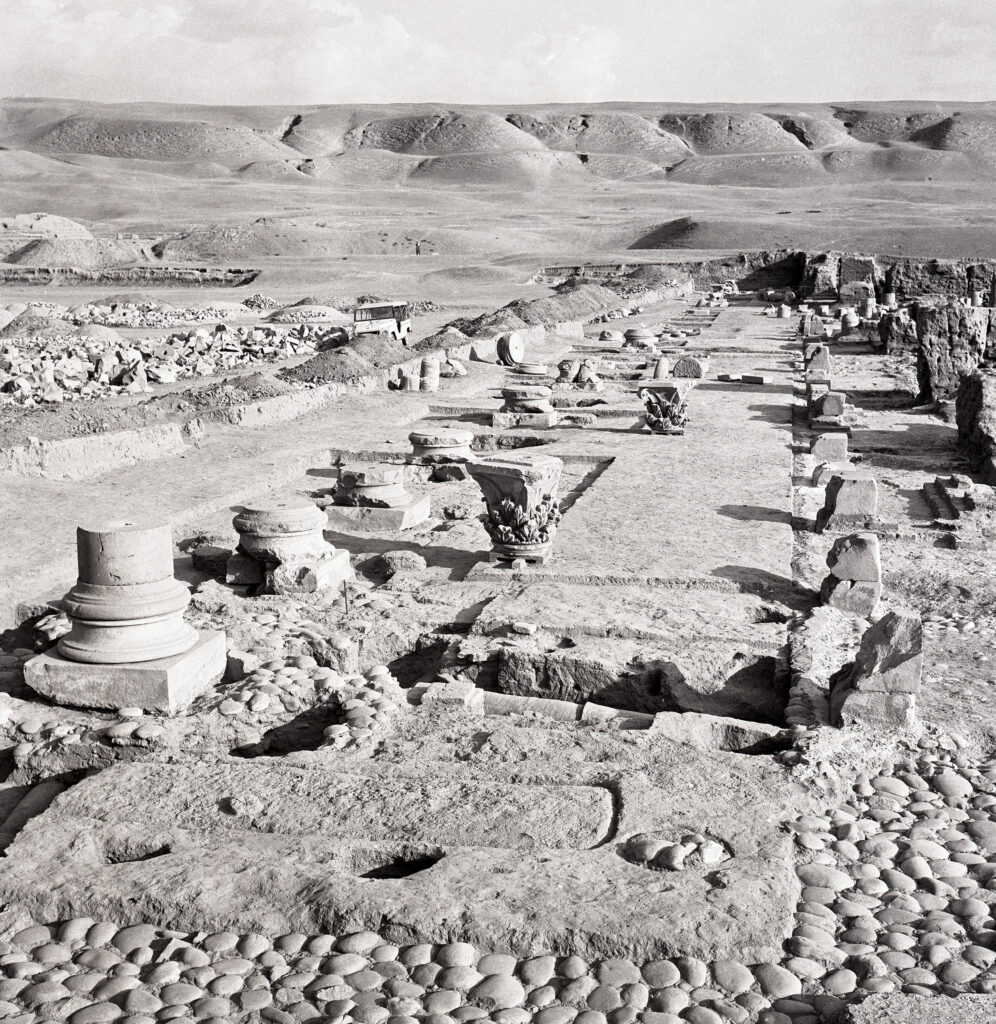

The precise date of Ai-Khanoum‘s initial foundations remains unknown. Interesting enough, Ai-Khanoum was erected some 20 kilometers south of Shortugai, an outpost and trading colony of the very innovative Indus Valley Civilization (also known as “Harappan”) during the late third millennium BC. (see my article here)
Shortugai was built with the typical Indus Valley standardized bricks. Indus Valley Civilization seals have also been found on other sites.
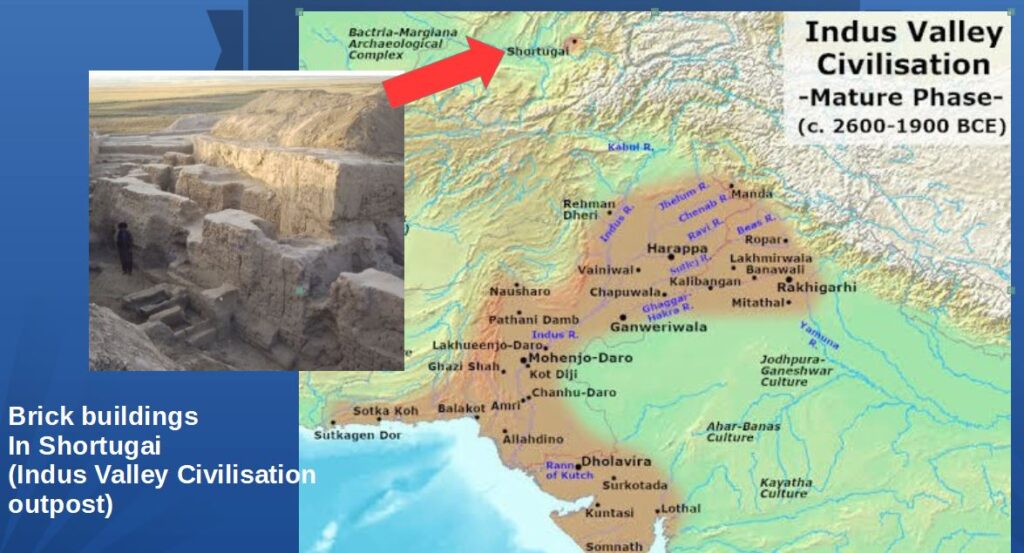
For several centuries Shortugai operated as an exceptional mining site for the extraction of tin, a key component of bronze, gold and the world famous magical blue gems of lapis lazuli used for the tomb of the Egyptian pharaon Toutankhamun and other major religious tombs in Mesopotamia (Iraq).
Shortugai traded with its southern neighbors of Ai-Khanoum and constructed the first irrigation systems in the area, a specialty of the Indus Valley Civilization.
In Ai-Khanoum, several inscriptions were found, along with coins, artifacts, and ceramics including from Indian origin showing the extensive trade relations of the city ! One monument in the heart of the city displayed a stela inscribed in Greek with a long list of maxims embodying the ideals of Greek life. Those were copied from Delphi and ended with:
« In childhood, learn good manners;
in youth, control your passions;
in old age, be of good counsel;
in death, have no regrets. »
Unfortunately, the onset of the Soviet-Afghan War in the late 1970s halted scholarly progress and during the following conflicts in Afghanistan, the site was extensively looted.
The excavations in Ai-Khanoum nevertheless show archaeological evidence of the Greek presence and their peaceful coexistence with the local populations in this region.
Its architecture remains very Greek, but has also integrated various artistic influences and cultural elements which they saw during their travel from the Mediterranean area to Central Asia. For example, they used the Neo-Babylonian and Achaemenid styles – for the construction of their courtyards.
Here are some of the findings of the DAFA, most of them in possession and eventually on display at the National Museum in Kabul.
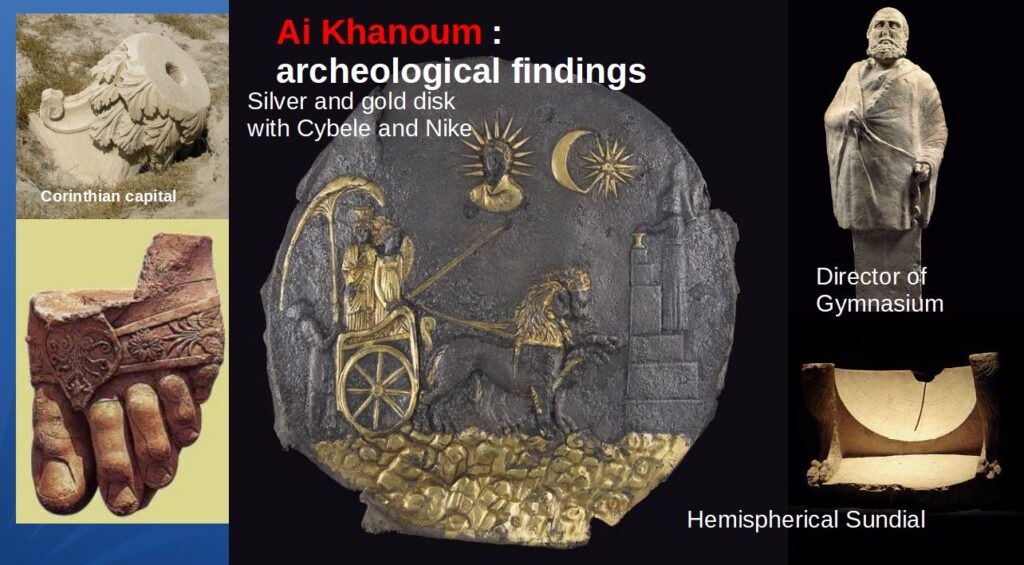
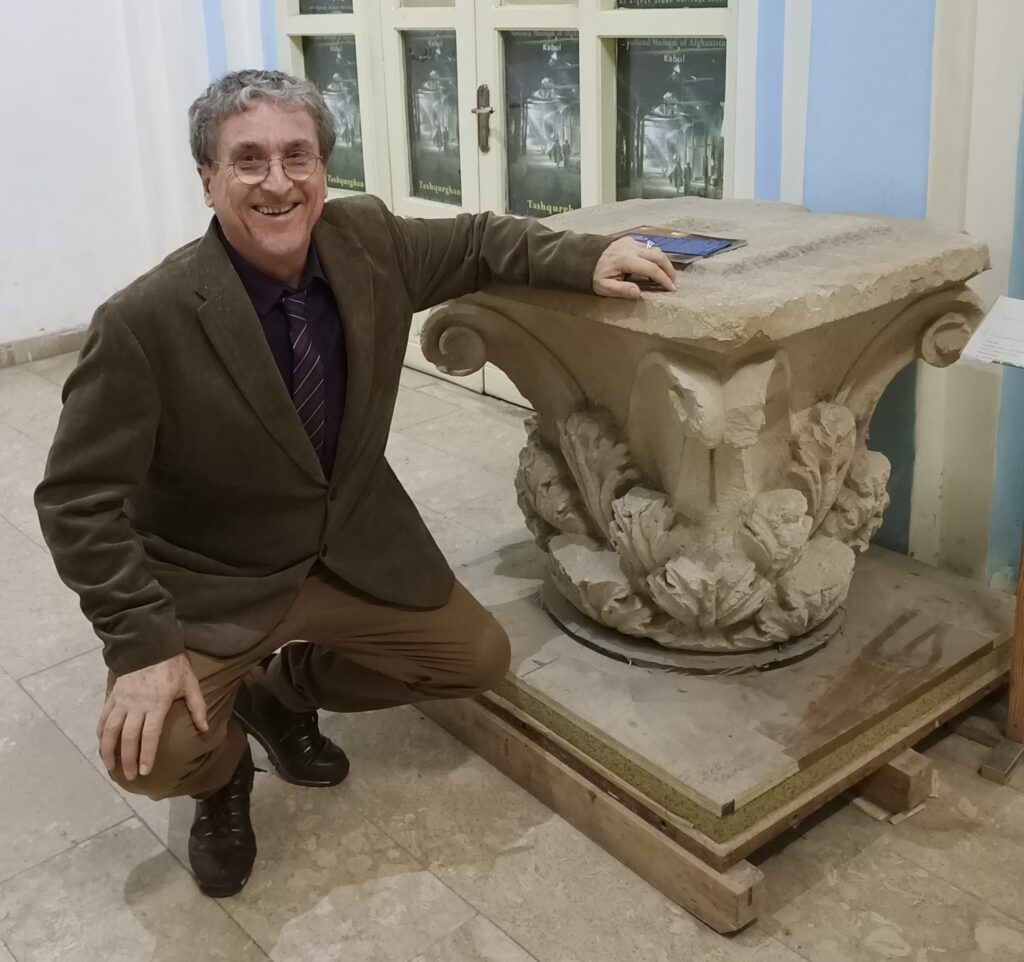
Surrounded by well-irrigated farmland, the city itself was divided between a lower town and a 60-meter-high (200 ft) acropolis. Although not situated on a major trade route, Ai-Khanoum controlled access to both mining in the Hindu Kush and strategically important choke points. Extensive fortifications, which were continually maintained and improved, surrounded the city.
Trading with India
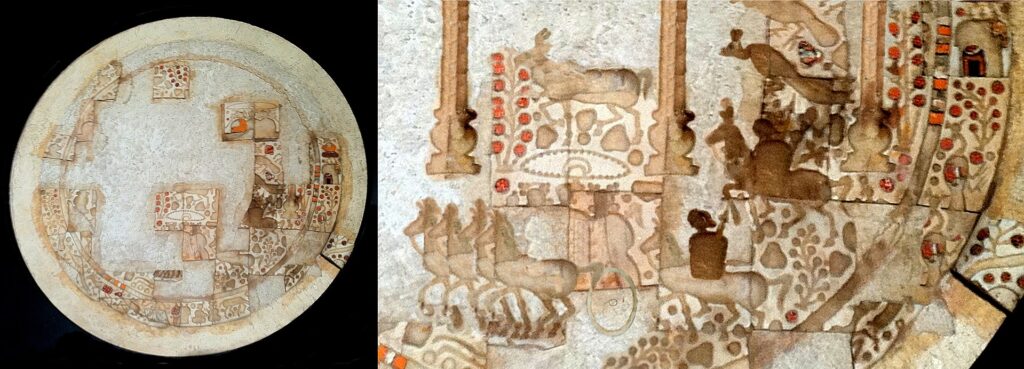
Ai-Khanoum also became an important trade hub with India. It is a testament to the level of Greek interaction with India and the influence of urban centres such as Ai-Khanoum in the region that even as early as 258 BCE, Ashoka the Great, ruler of the Maurya Empire (the dominant state in India), created the so-called « Kandahar Greek Edict of Ashoka », a bilingual rock inscription written in Greek and Aramaic. Another of Ashoka’s inscriptions near Kandahar was written solely in Greek. The actual content of these edicts also gives a clear indication of the level of exchange between India and the Hellenistic world. In his 13th Edict, Ashoka accurately names all of the rulers in the Hellenistic world at the time of the inscription.

Relations with China
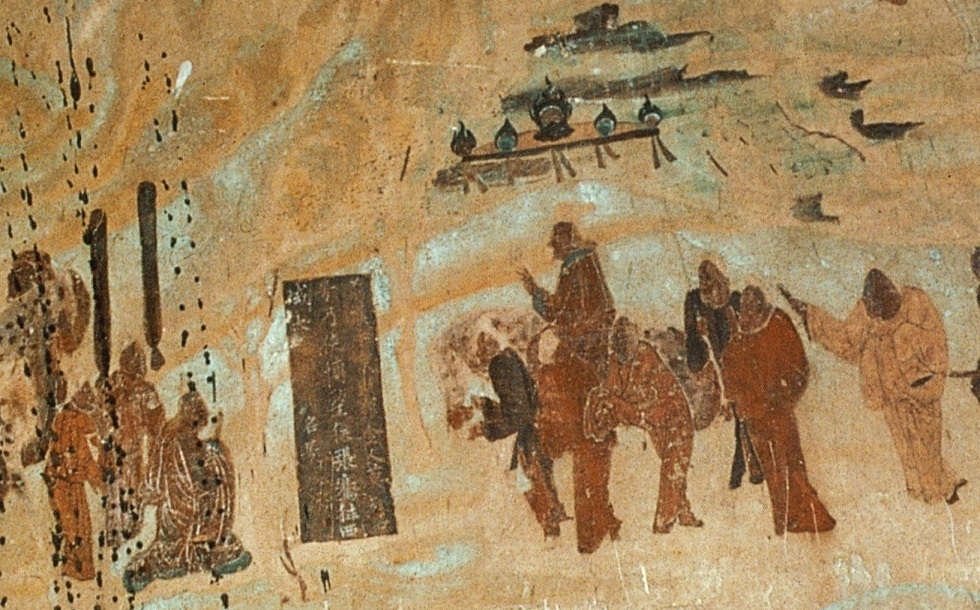
In addition to its interaction with the Indian subcontinent, the Greco-Bactrian Kingdom as a whole would eventually come to develop increasing contacts with a power even further to the East: China.
In the late Second Century BC, Zhang Qian, a Han dynasty diplomat and explorer, arrived in Bactria. His account of his visit to Bactria, including his recollection of his amazement at finding Chinese goods in the markets (acquired via India), as well as his travels in the rest of Central Asia, is preserved in the works of the early Han historian Sima Qian.
Upon returning to China, Zhang Qian informed the Emperor of the sophisticated urban civilisations in Ferghana, Bactria and Parthia. Zhang Qian’s discoveries prompted the Emperor to dispatch Chinese envoys across Central Asia to negotiate and encourage trade with China. Some historians are convinced that « this was the birth of the Silk Road. »

Many of the present ruins of Ai-Khanoum date from the time of Eucratides I (reigned 172–145 BC), who substantially redeveloped the city and who may have renamed it Eucratideia, after himself.
Eucratides I was killed in 145 BC by his son and soon after his death, the Greco-Bactrian kingdom collapsed.
This invasion of Ai-Khanoum was probably carried out by the Iranian Saka tribes of Scythian origin driven south by the nomadic Chinese Yuezhi peoples, who in turn formed a second wave of invaders, in around 130 BC. The treasury complex of the city shows signs of having been plundered in two assaults, fifteen years apart.
According to eye-witness reports, some cities made arrangements with the invaders and organized peaceful co-existence. Urban cities that resisted, such as Ai-Khanoum, were plundered and burned to the ground.
Kushan Empire

Very soon, showing a very interesting process of sedentarization, after the Saka tribes, the Yuezhi themselves took over Bactria and created in the early Ist century the “Kushan Empire” encompassing much of what is now Uzbekistan, Afghanistan, Pakistan, and Northern India and which lasted from around the year 30 AD till its subjugation in 375 AD by the (persian) Kushanshahs, the name used to designate the Kushano-Sasanian Kingdom that established its rule over Bactria over the declining Kushans.
The Kushan empire, which lasted till the end of 300 AD, was a center-point of the Silk Roads. Northern Pakistan and parts of India became part of the kingdom, which extended from Central Asia and Gandhara (Today’s western border of Pakistan) to Pataliputra on the Gangetic plain (today’s India). The main capital of his empire was located at Puruṣapura (today’s Peshawar in Pakistan).

Kanishka the Great was an emperor of the Kushan dynasty, under whose reign (c. 127–150 CE) the empire reached its zenith. He is famous for his military, political, and spiritual achievements. Under his rule, the Kushan Empire exchanged ambassadors with the Roman Emperor Marcus Aurelius (161-180) and the Han Emperor of China. He had had diplomatic contacts with Sassanian Persia and the Kingdom of Aksum (today’s Yemen and Saudi Arabia).
So while initially the Kushan dynasty followed Greek cultural ideas and iconography after the Greco-Bactrian tradition, they gradually developed their own.
For example, while initially they kept the Greek language for administrative purposes but in 127 AD, Kanisha replaced Greek with Bactrian, an Iranian language written in Greek letters, as the official language of administration in the empire.
In the domain of religion, the Kushans, which initially were attracted by Hinduism, would play a major role in the transmission of Mahayana Buddhism from Gandhara across the Karakoram range to China, Central Asia and even Sri Lanka, favoring the overall expansion of the Silk Road.
All of these factors ushered in a period of relative peace for 200 years, sometimes described as “Pax Kushana”.
From the middle of the 3rd century AD, the weakened Kushan kingdom began to disintegrate. In its western part, it came under the control of the (persian) Sassanids, gradually supplanted in the north by the Hephtalites (Called the « White » or « Iranian Huns ») from the Central Asian steppe.
Buddhism nevertheless enjoyed a period of great prosperity, as illustrated by the descriptions of the VIIth century Chinese monk Xuanzang and the construction of the giant buddha statues of the Bamiyan Valley in Afghanistan.
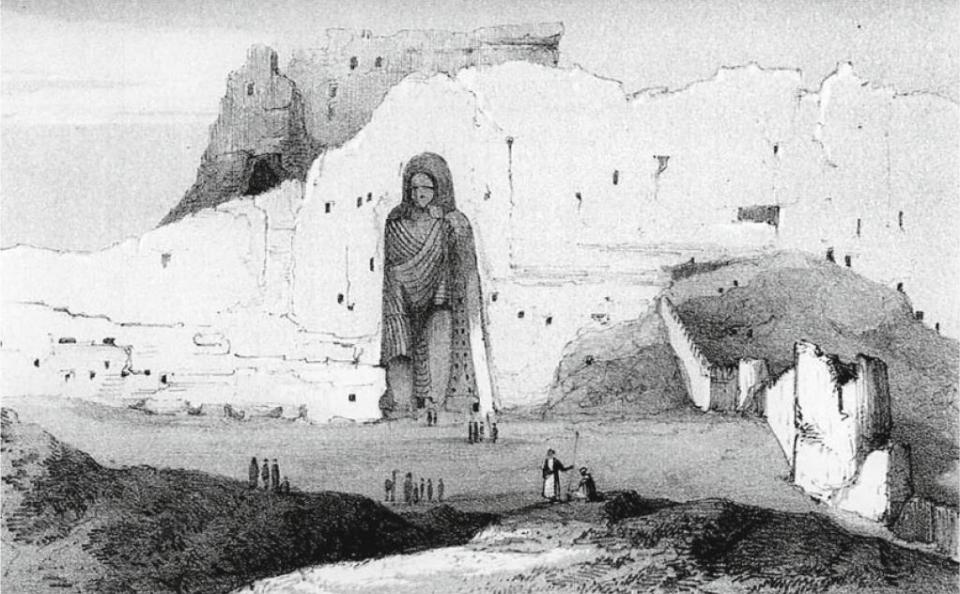
Islam
After conquering Iran, Islam penetrated Afghanistan from the north. There is no evidence of mass rejection of the new religion, except in isolated areas. However, the desire to remain independent from the governors appointed by Damascus and then Baghdad soon became apparent. It was even from a province covering part of northern Afghanistan, Khorasan, that part of an insurrection spread against the Umayyad to replace them with the more humanist Abbasid Caliphate of Harun-al-Rachid and the creation of Baghdad (see my article here)
From the end of the Xth century, a dynasty of Turkish origin, the Ghaznevids, built a vast sultanate around their capital Ghazni, extending as far as India and establishing a long-lasting Muslim community.

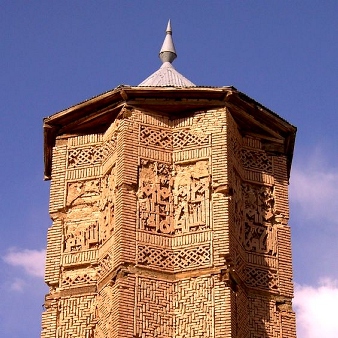
Their cultural influence can be measured by the beauty of the architecture they left us, but also by the patronage they gave to the great poet Ferdowsi (940-1025), to whom we owe the great Persian-language national epic Shahnameh: The Book of Kings.
The Ghaznevids were followed by a new dynasty, the Ghorids, from the central Hindu Kush. It was to them that we owe Jam’s “Minaret”.
Much of this rich cultural heritage, which laid the foundations of their identity and gave dignity to the Afghan people, has been ignored, destroyed in successive wars, looted and plundered.
ISIS, Daech and other terrorist groups, some of them backed by certain western intelligence agencies, currently being eliminated by the Afghan government, have engaged in industrial plunder using their loot as a source of income.
Recommandations
Today, the time is ripe for a new beginning. Afghanistan can completely change its image in the world, which currently has been polluted by adversaries and enemies that want to keep Afghanistan a zone of non-development for their own new geopolitical Great Game.
My proposal to renew Afghanistan’s contribution to world culture is simple.
Mes Aynak, meaning “Little Mine”, 35 km south of Kabul, is in reality the world’s second largest copper reserve. While China and other BRICS countries need copper for industrial development, the mine could generate a substantial income which Afghanistan urgently requires to rebuild the country.
On May 25, 2008, Ibrahim Adel, Minister of Mines, and Shen Heting, general manager of MCC, the MCC-Jiangxi Copper MJAM consortium’s majority stakeholder, signed the Mes Aynak mining contract. The contract described the conditions for the first major mining project andbiggest foreign investment in Afghanistan.
However, after security incidents created major insecurity problems, and pressured by foreign powers, the project was stalled.

Archeological remains of Buddhist complex in Mes Aynak copper mine.
Paradoxically, this gave archeologists the time to unearth on the mining site an area of 40 ha of exceptional world class cultural value, mainly a vast complex of buddhist monasteries, including stupas (temples), murals, sculptures and hundreds of archeological artifacts, and more.
Even if the contract (pdf file) might have been modified since 2008, one cannot but note that the initial contract contains a series of potentially very interesting aspects, both for China but mainly for Afghanistan itself.
- SMELTER
Just as Bolivia doesn’t want to export lithium (as a raw material) but batteries (a finished transformed product with high added value), Afghanistan doesn’t want to export copper ore but copper metal. To achieve that aim, the contract plans to build a smelter on the site Part IV, 33: « In order to fulfill its commitment to the Government to fund, construct and operate a smelter in Afghanistan, MCC has requested that the Government provide access to deposits of phosphats, limestone and quartz for MCC’s use in the Aynak Project. » - LOCAL PURCHASING
Part VII, 38: « MCC shall use its best efforts to purchase goods and services in Afghanistan if they are available. » - LOCAL WORKFORCE
Part VIII, 39, a : « MCC shall employ Afghan personnel, to the maximum extent practicable. » - WATER
Part IV, 32: « MCC has made a commitment to the Government to construct water supply wells and pipeline systems … to supply the project’s fresh water requirements. MCC has also committed to reuse and re-circulate process water to the extent possible. » - POWER SUPPLY
Part IV, 31: « MCC has made a commitment to the Ministry of Mines to construct … one 400 megawatt capacity coal fired plant to supply electrical power to the project and to Kabul. » - RAILWAY
Part IV, 30: « MCC has committed to construct a railway associated with the project ». - HOUSING
Part IV, 24: « MCC shall provide housing facilities of sufficient quality and quantity for its employees and their immediate families at a reasonable rental rate. » - MEDICAL FACILITIES
Part IV, 25: « MCC shall furnish free medical care and attention to all its employees and families of employees … and shall establish, staff and maintain sufficient dispensary, clinic and hospital facilities … » - SCHOOLS
Part IV, 26: « MCC shall provide, free of charge, adequate primary and secondary school education for the children of all employees and residents in the area surrounding Aynak. » - ENTERTAINMENT AND SHOPPING
Part IV, 27: « MCC shall construct and fund the operation of adequate recreational activity centers such as gymnasiums and sport fields. … In addition, it shall construct a market/shopping area. » - RELIGION
Part IV, 28: MCC shall « respect and protect the religious belief of the Afghan people. »
The world would be stunned if Afghanistan would mobilize its best architects and city builders and make the new city under construction in Mes Aynak « The Aï Khanoum of the XXIst Century ». Let’s think about it.
According to a senior field archeologist who worked on the site for a decade, following intense discussions last October between the Afghan authorities and the Chinese company, big progress has been made. As of now, he says, both are fully committed to preserve the entire historical remains on the surface and not only a small part. While the contract planned to do « open-pit » mining in the western part and only wanted to preserve the central part with the Buddhist stupas (temples), from now on, says this highly credible source, the entire site will be mined by (more expensive) underground mining exploitation techniques that will leave the surface historical remains untouched.
If the world discovers the remains of the Mes Aynak buddhist monasteries are saved, Afghanistan’s image in the world will change. In a second period, it might become much easier to consider the reconstruction of the Bamiyan giant buddha statues, one of 55 meters and the other of 38 meters, destroyed in 2001.
It has been scientifically demonstrated by several experts speaking at conferences of UNESCO that this is not a technical problem and relatively easy to accomplish. The so-called “danger” that the sculptures would be considered as “fake” makes no sense, as long as the intention to reach a higher good by their reconstruction is real.
The 2017 “Technical Proposal for Revitalizing the Bamiyan Buddha Statues”, by the department of architecture of the Japanese Mukogawa Women’s University should be studied. It needs to be improved but it has the merit to exist. One should not forget that 620 million Buddhists in the world consider Bamiyan as a part of their own culture and might consider coming to Afghanistan to visit the site.
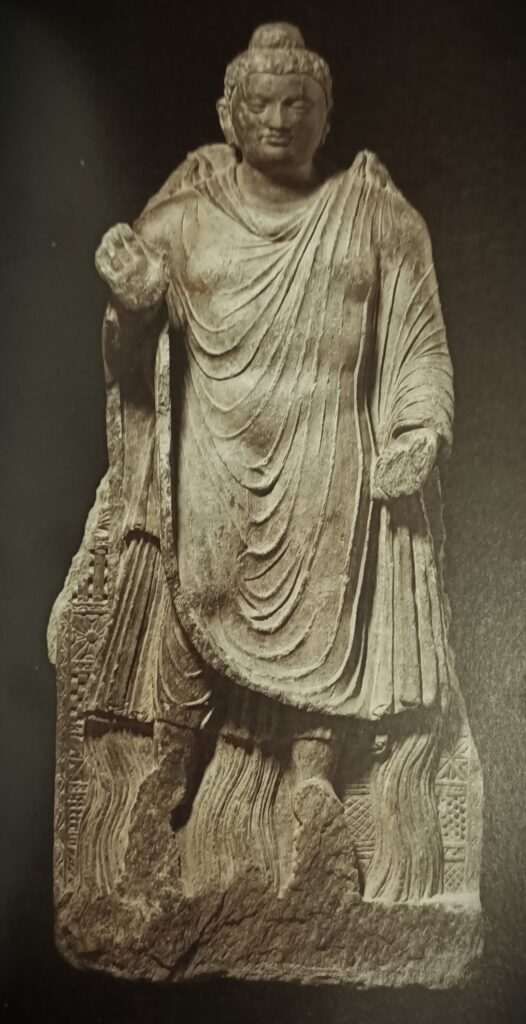
If Afghanistan would make it clear to the world it has decided to bolster its economic and mining activities but in the same time will protect at all cost and, in this case, with generous Chinese help, the world’s cultural heritage on its soil, it would underline its willingness to act as a force of good, tolerance and peace in the world, in coherence with its own identity and history.
An Afghan economic and cultural « miracle » would impress the world as much as Buddha in the story of the Greek influenced Buddha statue found north of Kabul in 1965.
Called the « Fire Buddha » (IInd-IIIrd Century) it represents Buddha’s response to a challenge from heretics that he could not perform miracles.
Known as « The Twin miracles », flames emanated from his shoulders and water poured from his feet, demonstrating his pre-eminence. By alternating both currents (fire and water), a wonderful rainbow appeared and convinced the heretics this man definitely was kind of special.
Today, in a simular miracle, by boosting its energy production and smart water management, Afghanistan will demonstrate its spiritual strength !
Thank You,
Comments are Closed